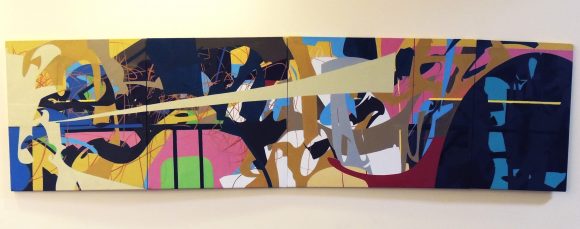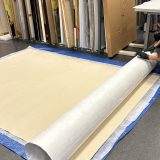Visualizing Wilkinson Through Art Escalette Collection's New Plan
May 20, 2020
As a museum without walls, the Escalette Collection of Art is an expert at turning hallways into art galleries. Wilkinson College and the Escalette Collection are excited to announce plans for a new initiative to develop college-relevant art installations for Roosevelt Hall and Smith Hall – the buildings which house the Dean’s suite and humanities and social sciences departments. These art exhibits are being thoughtfully curated by the Escalette staff to showcase the college’s initiatives and goals, providing the campus with a visual representation of Wilkinson College, the heart and soul of Chapman University.
As an academic unit of the Wilkinson College, the mission of the Escalette Collection of Art is to support the research and academic interests of Wilkinson’s students, faculty, and staff by collecting and displaying art that inspires critical thinking and dialogue about contemporary issues and ideas.
The first phase of this expansion will focus on the center of Wilkinson College: the Dean’s Suite in Roosevelt Hall. Our collective goal was to display artwork and create a space that exemplifies the college’s commitment to diversity, inclusion, and equity and the creativity of our faculty. To this end, the selected artwork highlights the various interdisciplinary minors housed within the Wilkinson Dean’s Office. In addition, work by every full-time Art Department studio faculty member will be put on display.
The second phase of the new art program will focus on developing the first-floor hallway in Roosevelt Hall as a temporary exhibition space where the Escalette Collection can display new acquisitions or build displays relating to college initiatives. In Fall 2020, this space will showcase Black artists in the Escalette Collection in conjunction with Wilkinson College’s “Engaging the World: Leading the Conversation on the Significance of Race” initiative. Phase three will include installing artwork in Smith Hall that features recent acquisitions as well as developing meaningful displays of objects throughout Roosevelt and Smith Halls that connect to the specific departments housed in each space. Honoring our commitment to making exhibitions as accessible as possible, the Escalette Collection will create a variety of interpretive materials to enhance viewers’ ability to engage with the artwork, including digital versions of the displays and audio tours.
Let’s take a sneak peek of our overall plan for the Dean’s Suite and some of the artwork that will be displayed there!
•••

Floor plan of the Dean’s Suite with proposed artwork.
Born in San Bernardino, California to undocumented Mexican immigrant parents who have since become US citizens, Ramiro Gomez is known for addressing issues of immigration and making visible the “invisible” labor forces that keep the pools, homes, and gardens of Los Angeles in such pristine condition. His method for doing so involves placing life-size cardboard cut-outs of gardeners, nannies, and housekeepers on display in neighborhoods and parks around Beverly Hills, California. This painting captures Gomez’s work with cardboard and the vagueness of his forms that powerfully communicates the “invisibility” of the workers they represent.

Rotimi Fani-Kayode, Untitled, gelatin silver print, 1985/2018. Purchased with funds from the Ellingson Family.
Rotimi Fani-Kayode was a photographer who used his art to capture the black queer experience, to reject homophobia, and to fight for equal political representation during the AIDS crisis. Fani-Kayode was born in 1955 in Lagos, Nigeria. His father was a politician and chieftain of Ife, the ancestral Yoruba capital. At age 11, Kayode and his family moved to Brighton, England to flee the Nigerian Civil War.
Much of his early work was created during the height of the AIDS crisis and responded to the homophobia in Thatcherite England and his home country of Nigeria. His photos expressed black queerness, focused on cultural identity, and acted as political calls to action. His photographs combine African and European iconography as a way to contest the marginal status of Yoruba culture and explore the position of the black body in Western society.

Micol Hebron, Cabaray: Observatory Venus at the Lover’s Hour, Archival inkjet print, 2010. Purchased with funds from the Ellingson Family.
Micol Hebron is a performance artist and professor in the Art Department at Chapman University. This work, titled Cabarary: Observatory Venus at the Lover’s Hour is part of a series in which Hebron combines and recreates notable works from art history. This piece combines Alexandre Cabanel’s Birth of Venus and a photograph by Man Ray of a nude woman lying underneath his work Observatory Time: The Lovers. Hebron states that her works “intentionally ‘confuse’ images and authorship, fusing two or more pieces that have formal similarities.” Her inspiration for recreating famous works of art was born out of her art education background, creating an “artistic, authorial identity crisis” in the face of so many white male artists throughout art history.
Raised by artists, Seann Brackin spent his childhood in the American midwest before traveling tirelessly around the globe. He ended up in Los Angeles, where he currently works. Brackin has a BFA from the Pacific Northwest College of Art in painting with an emphasis on sculpture and contemporary art and an MFA from Claremont Graduate University in painting and sculpture. Brackin’s work is about the vitality, zeal, and life that he encountered on his journey across the world. His painting #28 imagines the world through time, place, and emotion, expressed by bright colors and dynamic forms. Brackin wants his art to not only tell his own story, but to create an experience that will let the viewer create their own. In 2020, Brackin organized and curated an international, virtual exhibition of art made during the Covid-19 quarantine.
•••
We invite you to explore all the works in the Escalette Collection by visiting our eMuseum.




